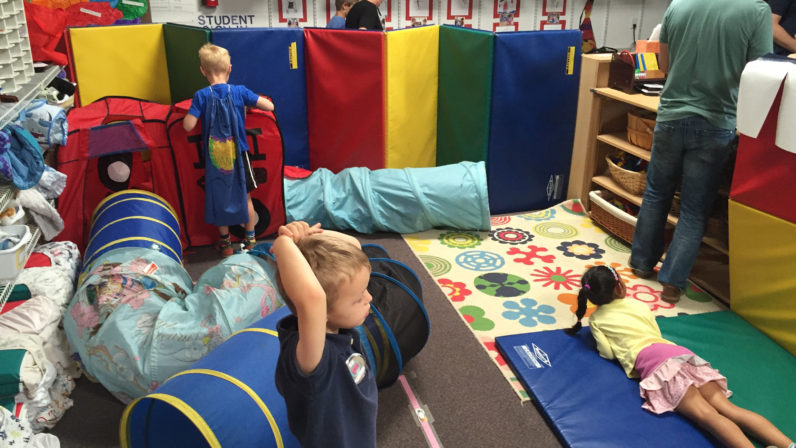It started with blood and poop, two hot topics in PreK since the beginning of the school year. When such preoccupations linger, there’s only one way to respond: embrace the interest and see where it goes. This happens often around the Seed. When toddlers are mesmerized by falling rain, the teacher sets up sensory experiences to help them absorb concepts like “wet” or “windy.” After reading a book about dinosaurs that captures preschoolers’ attention, a teacher might organize measuring activities that invite children to see first hand exactly how large a specific dinosaur may have been. Some teacher responses are subtle. Others come forward in a big way. Such was the case with Magic Body World.
Comments about blood and poop prevailed and a human body study emerged. It began with a heart taped to the floor. Students learned about the circulatory system from red and blue taped pathways moving away from and toward the heart. Small trucks carrying glass blobs became blood cells circulating. As the class moved on to the respiratory system, students spontaneously used lunch items (apple slices, peas, pita bread) to create their own models of body systems on the lunch tables. Life size body tracings with a photo of each child’s face lined the hallway wall. As each system was studied, learning was “recorded” by adding parts to the bodies. Before long, their traced bodies had a brain, a tongue with taste buds, the circulatory and respiratory systems, and finally, the digestive system. It was learning worthy of a theme park.
A plan soon came together, tickets were made, and invitations were sent out to each class. Displays were assembled, including a giant esophagus with lungs that children could crawl through, a model of the four-chambered heart big enough to play in, and a tent where viewers could sit in the dark to watch a quick video of the GI tract. There was a special setup for toddlers and preschoolers on the first day, then they ramped up the activities for the older kids. Disneyland designers could learn a lot from these preschoolers.
The physical setup was impressive; even more was how the children owned what they learned. When I approached the heart display area, I asked one of the girls to explain it. She grabbed a glass blob and said this: “The blob is the oxygen and you go through the heart. Then you drop off your oxygen blob somewhere at the body (at this point she placed the blob in a bowl with a plastic body part in it) and go through the blue part.” When I asked her what the blue part was, she exclaimed, “The atrium and the ventricle!” In a flash she moved on, continuing her “tour” of the exhibit. This child clearly knew her stuff.
I wasn’t the only one impressed. Third and fourth grade visitors each wrote a “Yelp” review of the Magic Body World theme park. This reviewer summed it up for all of us: “When I walked into the room I was so surprised. The efficient staff [the kids] greeted me as I walked in. The Temple of Digestion was my favorite part because it reminded me how you start with chewing the food and ended up in the potty. I was so surprised when the white blood cells came to save me. This was amazing.” It was amazing, and the complex theme park created to showcase their learning is just the beginning of what’s possible when children like these are given ownership of their curriculum.

